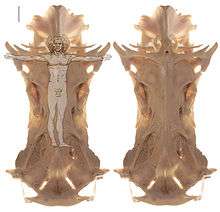Ariidae
The Ariidae or ariid catfish are a family of catfish that mainly live in marine waters with many freshwater and brackish water species. They are found worldwide in tropical to warm temperate zones. The family includes about 143 species.
| Ariidae | |
|---|---|
.jpg) | |
| Bagre marinus | |
| Scientific classification | |
| Kingdom: | Animalia |
| Phylum: | Chordata |
| Class: | Actinopterygii |
| Order: | Siluriformes |
| Superfamily: | Arioidea |
| Family: | Ariidae L. S. Berg, 1958 |
| Subfamilies | |
| |
Taxonomy
The relationships of this family are not yet clear.[1] Two of the genera, Gogo and Ancharius, have been moved to a separate family called Anchariidae.[2] The Ariidae are divided into three subfamilies: Galeichthys is the only genus classified in the subfamily Galeichthyinae and similarly Bagre is the only genus in the subfamily Bagreinae,[3] while the rest of the genera are classified in the subfamily Ariinae.[4]
Previously, the family Ariidae has been grouped in the superfamily Doradoidea, but then it was moved into Bagroidea (along with Austroglanididae, Claroteidae, Schilbeidae, Pangasiidae, Bagridae, Malapteruridae, and Pimelodidae.[5] It has also been classified in a superfamily Arioidea containing Ariidae and Anchariidae.[6]
Distribution and habitat
Ariids are found worldwide in tropical to warm temperate zones.[5] Ariids are unusual among catfish in that they live primarily in the sea; the majority of catfish families are strictly freshwater and have little tolerance for brackish or marine conditions. Ariid catfish are found in shallow temperate and tropical seas around the coastlines of North and South America, Africa, Asia, and Australia.
Many other species of catfish are also present in freshwater habitats; some species only occur in freshwater. In North and South America, about 43 species extend into brackish water or are found exclusively in fresh water.
Appearance and anatomy
Ariid catfish have a deeply forked caudal fin. Usually, three pairs of barbels are present. They possess some bony plates on their heads and near their dorsal fins.[5] At least some species have venomous spines in their dorsal and pectoral fins.[7]
Skull

The gaff top sail catfish is sometimes called crucifix catfish because their dried skulls bones resemble a cruciform man. This is an example of pareidolia.[8]
Ecology
Beyond their maritime habitat, ariid catfish have a number of unique adaptations that set them apart from other catfish. Most, if not all species, are mouthbrooding fish, with the male carrying a small clutch of a few dozen, tiny eggs for about two months until the eggs hatch and the fry become free-swimming.[9][10]
Relationship to humans
One well-known ariid catfish is the hardhead catfish, Ariopsis felis, abundant along the Western Atlantic coast from Massachusetts to Mexico. Although hardhead catfish reach a weight of about 5.5 kg (12 lb) and are edible, they have a mixed reputation as game fish and are often considered nuisance bait stealers.[11]
A less-abundant species, more highly regarded as a game and food fish, is the gafftopsail catfish, Bagre marinus. The range of the gafftop extends further south, to Venezuela.
The smaller ariid catfishes have minor value as public and home aquarium fish. In 1972, the Shedd Aquarium in Chicago received worldwide acclaim for the first successful breeding of Ariopsis felis in captivity, a feat they have repeated several times since. The Colombian shark catfish Sciades seemanni (until recently Hexanematichthys seemanni) is a fairly popular aquarium fish, though it has been traded under a variety of spurious names, such as Arius jordani and Arius seemani.[12] Less commonly traded aquarium species include Arius berneyi and Arius graeffei.[13]
References
- "A New Genus of the Fish Family Ariidae (Siluriformes), with A Redescription of Chinchaysuyoa labiata from Ecuador and A New Species Description from Peru". Novataxa. Retrieved 11 February 2019.
- Ng, Heok Hee; Sparks, John S. (2005). "Revision of the endemic Malagasy catfish family Anchariidae (Teleostei: Siluriformes), with descriptions of a new genus and three new species". Ichthyol. Explor. Freshwaters (PDF). 16 (4): 303–323.
- "Ariidae Bleeker, 1858". World Register of Marine Species. Retrieved 29 July 2017.
- Acero P., Arturo; Betancur-R., Ricardo (June 2007). "Monophyly, affinities, and subfamilial clades of sea catfishes (Siluriformes: Ariidae)" (PDF). Ichthyol. Explor. Freshwaters. 18 (2): 133–143. Retrieved 2009-06-25.
- Nelson, Joseph S. (2006). Fishes of the World. John Wiley & Sons, Inc. ISBN 0-471-25031-7.
- Sullivan, JP; Lundberg JG; Hardman M (2006). "A phylogenetic analysis of the major groups of catfishes (Teleostei: Siluriformes) using rag1 and rag2 nuclear gene sequences". Mol Phylogenet Evol. 41 (3): 636–62. doi:10.1016/j.ympev.2006.05.044. PMID 16876440.
- Froese, Rainer and Pauly, Daniel, eds. (2007). "Bagre marinus" in FishBase. May 2007 version.
- The Crucifix Catfish by Allan James
- Froese, Rainer, and Daniel Pauly, eds. (2007). "Ariidae" in FishBase. May 2007 version.
- Ariopsis felis
- "Hardhead Catfish". Archived from the original on 2006-07-21. Retrieved 2006-07-06.
- Hexanematichthys seemanni
- The catfish family Ariidae